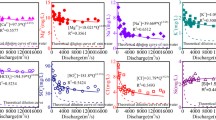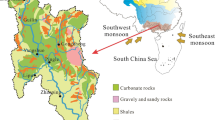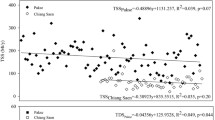Abstract
Understanding the mechanisms that lead various hydrological conditions to influence solute and carbon dynamics in karst rivers is a crucial issue. In this study, high-frequency sampling and analyses of water chemistry and ẟ13CDIC were conducted from October 2013 to September 2014 in a typical karst river, the Beipan River in southwestern China. The major ions (such as Ca2+, Mg2+, HCO3−, K+, SO42−, Na+, and Cl−) in the river are mainly from the weathering of carbonates and silicates and present temporal hydrological variabilities. Sr and U are mainly derived from carbonate weathering and show chemostatic behaviors responding to increasing discharge, similar to carbonate-sourced ions Ca2+, Mg2+, and HCO3−. Silicate weathering is the primary source of Al and Li, which show significant dilution effects similar to those of Na+ responding to high discharge. Meanwhile, most dissolved trace elements (such as Zn, Cu, Ba, Sb, Mn, Mo, and Pb) are strongly impacted by anthropogenic overprints and also exhibit a significant seasonal variability, which may be related with mining activities in the investigated area. A simultaneous increase of ẟ13CDIC and decrease in ∆DIC contents and pCO2 values suggests that photosynthesis is the primary control on riverine DIC variability during the high-flow season. Besides, the pCO2 values display significant chemostatic behaviors owing to the influx of biological CO2, which is produced by microbiological activities and ecological processes, and enhanced by monsoonal climatic conditions. A two-dimensional endmember mixing model demonstrates that carbonate weathering (averaging 62%) along with biological carbon (averaging 38%) are main sources to the riverine DIC, with temporal variability. Consequently, these results show that carbonate weathering and involved plant photosynthesis are the dominant processes controlling the riverine DIC contents under high discharge and temperature conditions. This work provides insight into the crucial influence of hydrological variability on solute sources and carbon dynamics under monsoonal climate for the karst rivers.









Similar content being viewed by others
References
Amaral JHF, Borges AV, Melack JM, Sarmento H, Barbosa PM, Kasper D, de Melo ML, De Fex-Wolf D, da Silva JS, Forsberg BR (2018) Influence of plankton metabolism and mixing depth on CO2 dynamics in an Amazon floodplain lake. Sci Total Environ 630:1381–1393. https://doi.org/10.1016/j.scitotenv.2018.02.331
Aucour A-M, Sheppard SMF, Guyomar O, Wattelet J (1999) Use of 13C to trace origin and cycling of inorganic carbon in the Rhône river system. Chem Geol 159(1–4):87–105. https://doi.org/10.1016/s0009-2541(99)00035-2
Baronas JJ, Torres MA, Clark KE, West AJ (2017) Mixing as a driver of temporal variations in river hydrochemistry: 2. Major and trace element concentration dynamics in the Andes-Amazon transition. Water Resour Res 53(4):3120–3145. https://doi.org/10.1002/2016WR019729
Brunet F, Dubois K, Veizer J, Nkoue Ndondo GR, Ndam Ngoupayou JR, Boeglin JL, Probst JL (2009) Terrestrial and fluvial carbon fluxes in a tropical watershed: Nyong basin, Cameroon. Chem Geol 265(3–4):563–572. https://doi.org/10.1016/j.chemgeo.2009.05.020
Cerling TE, Solomon DK, Quade J, Bowman JR (1991) On the isotopic composition of carbon in soil carbon dioxide. Geochim Cosmochim Acta 55(11):3403–3405. https://doi.org/10.1016/0016-7037(91)90498-t
Chen J-B, Gaillardet J, Bouchez J, Louvat P, Wang YN (2014) Anthropophile elements in river sediments: overview from the Seine River, France. Geochem Geophys Geosyst 15:4526–4546. https://doi.org/10.1002/2014GC005516
Chen B, Yang R, Liu Z, Sun H, Yan H, Zeng Q, Zeng S, Zeng C, Zhao M (2017) Coupled control of land uses and aquatic biological processes on the diurnal hydrochemical variations in the five ponds at the Shawan Karst Test Site, China: implications for the carbonate weathering-related carbon sink. Chem Geol 456:58–71. https://doi.org/10.1016/j.chemgeo.2017.03.006
Clow DW, Mast MA (2010) Mechanisms for chemostatic behavior in catchments: implications for CO2 consumption by mineral weathering. Chem Geol 269(1–2):40–51. https://doi.org/10.1016/j.chemgeo.2009.09.014
Colombo N, Gruber S, Martin M, Malandrino M, Magnani A, Godone D, Freppaz M, Fratianni S, Salerno F (2018) Rainfall as primary driver of discharge and solute export from rock glaciers: the Col d’Olen Rock Glacier in the NW Italian Alps. Sci Total Environ 639:316–330. https://doi.org/10.1016/j.scitotenv.2018.05.098
Correa A, Breuer L, Crespo P, Célleri R, Feyen J, Birkel C, Silva C, Windhorst D (2019) Spatially distributed hydro-chemical data with temporally high-resolution is needed to adequately assess the hydrological functioning of headwater catchments. Sci Total Environ 651:1613–1626. https://doi.org/10.1016/j.scitotenv.2018.09.189
Cox PM, Betts RA, Jones CD, Spall SA, Totterdell IJ (2000) Acceleration of global warming due to carbon-cycle feedbacks in a coupled climate model. Nature 408:184–187. https://doi.org/10.1038/35047138
Dessert C, Dupré B, Gaillardet J, François LM, Allègre CJ (2003) Basalt weathering laws and the impact of basalt weathering on the global carbon cycle. Chem Geol 202(3–4):257–273. https://doi.org/10.1016/j.chemgeo.2002.10.001
Diamond JS, Cohen MJ (2018) Complex patterns of catchment solute-discharge relationships for coastal plain rivers. Hydrol Process 32(3):388–401. https://doi.org/10.1002/hyp.11424
Doctor DH, Kendall C, Sebestyen SD, Shanley JB, Ohte N, Boyer EW (2008) Carbon isotope fractionation of dissolved inorganic carbon (DIC) due to outgassing of carbon dioxide from a headwater stream. Hydrol Process 22(14):2410–2423. https://doi.org/10.1002/hyp.6833
Duvert C, Butman DE, Marx A, Ribolzi O, Hutley LB (2018) CO2 evasion along streams driven by groundwater inputs and geomorphic controls. Nat Geosci 11(11):813–818. https://doi.org/10.1038/s41561-018-0245-y
Gaillardet J, Dupré B (2005) Trace element in river water: treatise on geochemistry. In: Drever JJ, Holland HD (eds) Surface and ground water weathering and soils. Elsevier, Turekian, pp 25–272
Gaillardet J, Dupre B, Allegre CJ, Negrel P (1997) Chemical and physical denudation in the Amazon River basin. Chem Geol 142:141–173. https://doi.org/10.1016/S0009-2541(97)00074-0
Gaillardet J, Dupré B, Louvat P, Allègre CJ (1999) Global silicate weathering and CO2 consumption rates deduced from the chemisry of rivers. Chem Geol 159:3–30. https://doi.org/10.1016/S0009-2541(99)00031-5
Gammons CH, Babcock JN, Parker SR, Poulson SR (2010) Diel cycling and stable isotopes of dissolved oxygen, dissolved inorganic carbon, and nitrogenous species in a stream receiving treated municipal sewage. Chem Geol 283:44–55. https://doi.org/10.1016/j.chemgeo.2010.07.006
Garzanti E, Andò S, France-Lanord C, Censi P, Vignola P, Galy V, Lupker M (2011) Mineralogical and chemical variability of fluvial sediments 2. Suspended-load silt (Ganga–Brahmaputra, Bangladesh). Earth Planet Sci Lett 302(1–2):107–120. https://doi.org/10.1016/j.epsl.2010.11.043
Georg RB, Reynolds BC, Frank M, Halliday AN (2006) Mechanisms controlling the silicon isotopic compositions of river waters. Earth Planet Sci Lett 249(3–4):290–306. https://doi.org/10.1016/j.epsl.2006.07.006
Godsey SE, Kirchner JW, Clow DW (2009) Concentration-discharge relationships reflect chemostatic characteristics of US catchments. Hydrol Process 23(13):1844–1864. https://doi.org/10.1002/hyp.7315
Han ZJ, Jin ZS (1996) Hydrology of Guizhou Province. Seismology Press, China
Jiang H, Liu W, Zhao T, Sun H, Xu Z (2018) Water geochemistry of rivers draining karst-dominated regions, Guangxi province, South China: implications for chemical weathering and role of sulfuric acid. J Asian Earth Sci 163:152–162. https://doi.org/10.1016/j.jseaes.2018.05.017
Juhlke TR, Van Geldern R, Huneau F, Garel E, Santoni S, Hemmerle H, Barth JAC (2019) Riverine carbon dioxide evasion along a high-relief watercourse derived from seasonal dynamics of the water-atmosphere gas exchange. Sci Total Environ 657:1311–1322. https://doi.org/10.1016/j.scitotenv.2018.12.158
Kirchner JW, Neal C (2013) Universal fractal scaling in stream chemistry and its implications for solute transport and water quality trend detection. Proc Natl Acad Sci USA 110(30):12213–12218. https://doi.org/10.1073/pnas.1304328110
Koger JM, Newman BD, Goering TJ (2018) Chemostatic behaviour of major ions and contaminants in a semiarid spring and stream system near Los Alamos, NM, USA. Hydrol Process 32(11):1709–1716. https://doi.org/10.1002/hyp.11624
Krishna MS, Viswanadham R, Prasad MHK, Kumari VR, Sarma VVSS (2018) Export fluxes of dissolved inorganic carbon to the Northern Indian Ocean from the Indian monsoonal rivers. Biogeosci Discuss 16(2):505–519. https://doi.org/10.5194/bg-2018-4
Li SY (2018) CO2 oversaturation and degassing using chambers and a new gas transfer velocity model from the Three Gorges Reservoir surface. Sci Total Environ 640-641:908–920. https://doi.org/10.1016/j.scitotenv.2018.05.345
Li SY, Bush RT (2015) Changing fluxes of carbon and other solutes from the Mekong River. Sci Rep 5:16005. https://doi.org/10.1038/srep16005
Li Yung Lung JYS, Tank SE, Spence C, Yang D, Bonsal B, McClelland JW, Holmes RM (2018) Seasonal and geographic variation in dissolved carbon biogeochemistry of rivers draining to the Canadian Arctic Ocean and Hudson Bay. J Geophys Res Biogeosci 123(10):3371–3386. https://doi.org/10.1029/2018jg004659
Li S-L, Liu C-Q, Tao F-X, Lang Y-C, Han G-L (2005) Carbon biogeochemistry of ground water, Guiyang, Southwest China. Groundwater 43(4):494–499. https://doi.org/10.1111/j.1745-6584.2005.0036.x
Li S-L, Calmels D, Han G, Gaillardet J, Liu C-Q (2008) Sulfuric acid as an agent of carbonate weathering constrained by δ13CDIC: examples from Southwest China. Earth Planet Sci Lett 270(3–4):189–199. https://doi.org/10.1016/j.epsl.2008.02.039
Li S-L, Liu C-Q, Li J, Lang Y-C, Ding H, Li L (2010) Geochemistry of dissolved inorganic carbon and carbonate weathering in a small typical karstic catchment of Southwest China: isotopic and chemical constraints. Chem Geol 277(3–4):301–309. https://doi.org/10.1016/j.chemgeo.2010.08.013
Liu Z, Liu X, Liao C (2008) Daytime deposition and nighttime dissolution of calcium carbonate controlled by submerged plants in a karst spring-fed pool: insights from high time-resolution monitoring of physico-chemistry of water. Environ Geol 55(6):1159–1168. https://doi.org/10.1007/s00254-007-1062-6
Liu J, Li S-L, Chen J-B, Zhong J, Yue F-J, Lang Y, Ding H (2017a) Temporal transport of major and trace elements in the upper reaches of the Xijiang River, SW China. Environ Earth Sci 76(7):299–217. https://doi.org/10.1007/s12665-017-6625-6
Liu J, Li S-L, Zhong J, Zhu XT, Guo QJ, Lang YC, Han XK (2017b) Sulfate sources constrained by sulfur and oxygen isotopic compositions in the upper reaches of the Xijiang River, China. Acta Geochima 36(4):611–618. https://doi.org/10.1007/s11631-017-0175-1
Maher K, Chamberlain CP (2014) Hydrologic regulation of chemical weathering and the geologic carbon cycle. Science 343(6178):1502–1504. https://doi.org/10.1126/science.1250770
McClanahan K, Polk J, Groves C, Osterhoudt L, Grubbs S (2016) Dissolved inorganic carbon sourcing using δ13CDIC from a karst influenced river system. Earth Surf Process Landf 41(3):392–405. https://doi.org/10.1002/esp.3856
Musolff A, Schmidt C, Selle B, Fleckenstein JH (2015) Catchment controls on solute export. Adv Water Resour 86:133–146. https://doi.org/10.1016/j.advwatres.2015.09.026
Ollivier P, Hamelin B, Radakovitch O (2010) Seasonal variations of physical and chemical erosion: a three-year survey of the Rhone River (France). Geochim Cosmochim Acta 74(3):907–927. https://doi.org/10.1016/j.gca.2009.10.037
Palmer MR, Edmond JM (1993) Uranium in river water. Geochim Cosmochim Acta 57:4947–4955. https://doi.org/10.1016/00167037(93)90131-F
Pant RR, Zhang F, Rehman FU, Wang G, Ye M, Zeng C, Tang H (2018) Spatiotemporal variations of hydrogeochemistry and its controlling factors in the Gandaki River Basin, Central Himalaya Nepal. Sci Total Environ 622-623:770–782. https://doi.org/10.1016/j.scitotenv.2017.12.063
Poulson SR, Sullivan AB (2010) Assessment of diel chemical and isotopic techniques to investigate biogeochemical cycles in the upper Klamath River, Oregon, USA. Chem Geol 269:3–11. https://doi.org/10.1016/j.chemgeo.2009.05.016
Qi C, Yang Y (2011) The geology and prospecting potentiality of Lida Sb deposit in Funing, Yunnan. Yunnan Geol 30(3):294–298 (in Chinese)
Qin J, Huh Y, Edmond JM, Du G, Ran J (2006) Chemical and physical weathering in the Min Jiang, a headwater tributary of the Yangtze River. Chem Geol 227(1–2):53–69. https://doi.org/10.1016/j.chemgeo.2005.09.011
Qing W-q, He M-f, Chen Y-p (2008) Improvement of flotation behavior of Mengzi lead-silver-zinc ore by pulp potential control flotation. Trans Nonferrous Metals Soc China 18(4):949–954. https://doi.org/10.1016/s1003-6326(08)60164-8
Qu B, Zhang Y, Kang S, Sillanpää M (2019) Water quality in the Tibetan Plateau: major ions and trace elements in rivers of the “Water Tower of Asia”. Sci Total Environ 649:571–581. https://doi.org/10.1016/j.scitotenv.2018.08.316
Rai SK, Singh SK, Krishnaswami S (2010) Chemical weathering in the plain and peninsular sub-basins of the Ganga: impact on major ion chemistry and elemental fluxes. Geochim Cosmochim Acta 74(8):2340–2355. https://doi.org/10.1016/j.gca.2010.01.008
Rose LA, Karwan DL, Godsey SE (2018) Concentration-discharge relationships describe solute and sediment mobilization, reaction, and transport at event and longer timescales. Hydrol Process 32(18):2829–2844. https://doi.org/10.1002/hyp.13235
Schulte P, van Geldern R, Freitag H, Karim A, Négrel P, Petelet-Giraud E, Probst A, Probst J-L, Telmer K, Veizer J, Barth JAC (2011) Applications of stable water and carbon isotopes in watershed research: weathering, carbon cycling, and water balances. Earth Sci Rev 109(1–2):20–31. https://doi.org/10.1016/j.earscirev.2011.07.003
Shin WJ, Chung GS, Lee D, Lee KS (2011) Dissolved inorganic carbon export from carbonate and silicate catchments estimated from carbonate chemistry and δ13CDIC. Hydrol Earth Syst Sci 15(8):2551–2560. https://doi.org/10.5194/hess-15-2551-2011
Singley JG, Wlostowski AN, Bergstrom AJ, Sokol ER, Torrens CL, Jaros C, Wilson CE, Hendrickson PJ, Gooseff MN (2017) Characterizing hyporheic exchange processes using high-frequency electrical conductivity-discharge relationships on subhourly to interannual timescales. Water Resour Res 53(5):4124–4141. https://doi.org/10.1002/2016wr019739
Szramek K, McIntosh JC, Williams EL, Kanduc T, Ogrinc N, Walter LM (2007) Relative weathering intensity of calcite versus dolomite in carbonate-bearing temperate zone watersheds: carbonate geochemistry and fluxes from catchments within the St. Lawrence and Danube river basins. Geochem Geophys Geosyst 8(4). doi: https://doi.org/10.1029/2006gc001337
Tamooh F, Borges AV, Meysman FJR, Van Den Meersche K, Dehairs F, Merckx R, Bouillon S (2013) Dynamics of dissolved inorganic carbonand aquatic metabolism in the Tana River Basin, Kenya. Biogeosciences 10:6911–6928. https://doi.org/10.5194/bg-10-6911-2013
Thompson SE, Basu NB, Lascurain J, Aubeneau A, Rao PSC. (2011). Relative dominance of hydrologic versus biogeochemical factors on solute export across impact gradients. Water Resour Res 47(10). doi: https://doi.org/10.1029/2010wr009605
Tipper ET, Bickle MJ, Galy A, West AJ, Pomiès C, Chapman HJ (2006) The short term climatic sensitivity of carbonate and silicate weathering fluxes: insight from seasonal variations in river chemistry. Geochim Cosmochim Acta 70(11):2737–2754. https://doi.org/10.1016/j.gca.2006.03.005
Torres MA, West AJ, Clark KE (2015) Geomorphic regime modulates hydrologic control of chemical weathering in the Andes–Amazon. Geochim Cosmochim Acta 166:105–128. https://doi.org/10.1016/j.gca.2015.06.007
Viers J, Oliva P, Dandurand J-L, Dupré B, Gaillardet J (2014) Chemical weathering rates, CO2 consumption, and control parameters deduced from the chemical composition of Rivers. Treatise on Geochemistry 175–194. https://doi.org/10.1016/B978-0-08-095975-7.00506-4
Voss BM, Peucker-Ehrenbrink B, Eglinton TI, Fiske G, Wang ZA, Hoering KA, Montluçon DB, LeCroy C, Pal S, Marsh S, Gillies SL, Janmaat A, Bennett M, Downey B, Fanslau J, Fraser H, Macklam-Harron G, Martinec M, Wiebe B (2014) Tracing river chemistry in space and time: dissolved inorganic constituents of the Fraser River, Canada. Geochim Cosmochim Acta 124:283–308. https://doi.org/10.1016/j.gca.2013.09.006
Waldron S, Scott EM, Soulsby C (2007) Stable isotope analysis reveals lower-order river dissolved inorganic carbon pools are highly dynamic. Environ Sci Technol 41:6156–6162. https://doi.org/10.1021/es0706089
Wei G, Ma J, Liu Y, Xie L, Lu W, Deng W, Ren Z, Zeng T, Yang Y (2013) Seasonal changes in the radiogenic and stable strontium isotopic composition of Xijiang River water: implications for chemical weathering. Chem Geol 343:67–75. https://doi.org/10.1016/j.chemgeo.2013.02.004
Xu ZF, Liu C-Q (2007) Chemical weathering in the upper reaches of Xijiang River draining the Yunnan–Guizhou Plateau, Southwest China. Chem Geol 239(1–2):83–95. https://doi.org/10.1016/j.chemgeo.2006.12.008
Yang SY, Wang ZB, Guo Y, Li CX, Cai JG (2009) Heavy mineral compositions of the Changjiang (Yangtze River) sediments and their provenance-tracing implication. J Asian Earth Sci 35(1):56–65. https://doi.org/10.1016/j.jseaes.2008.12.002
Zakharova EA, Pokrovsky OS, Dupré B, Zaslavskaya MB (2005) Chemical weathering of silicate rocks in Aldan Shield and Baikal Uplift: insights from long-term seasonal measurements of solute fluxes in rivers. Chem Geol 214(3–4):223–248. https://doi.org/10.1016/j.chemgeo.2004.10.003
Zhong J, Li S-L, Tao F, Ding H, Liu J (2017a) Impacts of hydrologic variations on chemical weathering and solute sources in the Min River basin, Himalayan-Tibetan region. Environ Sci Pollut Res 24(23):19126–19137. https://doi.org/10.1007/s11356-017-9584-2
Zhong J, Li S-L, Tao F, Yue F, Liu CQ (2017b) Sensitivity of chemical weathering and dissolved carbon dynamics to hydrological conditions in a typical karst river. Sci Rep 7:42944–42949. https://doi.org/10.1038/srep42944
Zhong J, Li S-L, Liu J, Ding H, Sun XL, Xu S, Wang TJ, Ellam RM, Liu C-Q (2018) Climate variability controls on CO2 consumption fluxes and carbon dynamics for monsoonal rivers: evidence from Xijiang River, Southwest China. J Geophys Res Biogeosci 123(8):2553–2567. https://doi.org/10.1029/2018jg004439
Acknowledgements
We deeply thank Dr. Si-Liang Li and Dr. Jun Zhong for their valuable comments that have largely improved the scientific writing of this paper, Dr. Fu-Jun Yue and Dr. Zhong-Jun Wang for their help in the field sampling, and the International Science Editing (http://www.internationalscienceediting.com) for editing this manuscript.
Funding
This work was supported financially by the National Natural Science Foundation of China (Grant No. 41807366), Guizhou Science and Technology Department Fund (Grant No. [2019]1043), Guizhou Education Department Fund (Grant No. [2018]161), and scientific platform talent project of Guizhou University of Finance and Economics (Grant No. [2018]5774-029).
Author information
Authors and Affiliations
Corresponding author
Additional information
Responsible editor: Philippe Garrigues
Publisher’s note
Springer Nature remains neutral with regard to jurisdictional claims in published maps and institutional affiliations.
Appendix
Appendix
Calculation of silicate and carbonate weathering fluxes:
The fluxes of silicate weathering (Fsil) and carbonate weathering (Fcarb) were calculated as follows:
where M is the molar mass of the element.
Rights and permissions
About this article
Cite this article
Liu, J., Chen, B., Xu, ZY. et al. Tracing solute sources and carbon dynamics under various hydrological conditions in a karst river in southwestern China. Environ Sci Pollut Res 27, 11375–11386 (2020). https://doi.org/10.1007/s11356-020-07650-6
Received:
Accepted:
Published:
Issue Date:
DOI: https://doi.org/10.1007/s11356-020-07650-6




